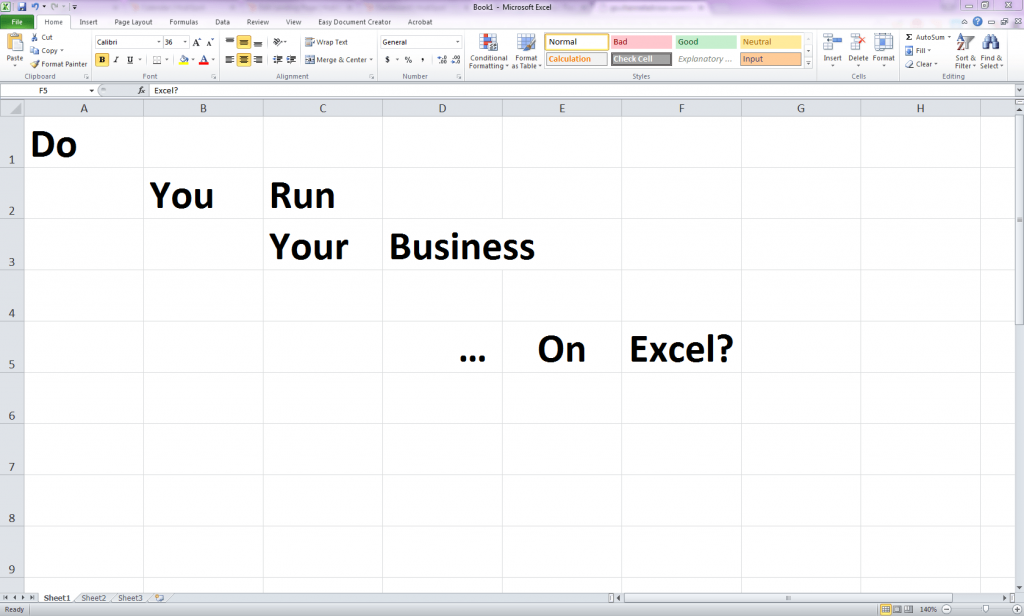We live in modern times. Yes, we really do.
No longer do we trudge into caves to draw antelope by firelight; we have smartphones and Snapchat to digitally send our poorly-drawn antelope to all of our friends and family instantly.
We’re not limited to two modes of transport any longer – horses or walking. These days we have trains and planes and these strange hoverboard things that are all the rage on Instagram.
It’s true, we’re living in the future that most of us take for granted on a daily basis.
So why are some businesses STILL running their day-to-day operations from none other than… an Excel Spreadsheet??

I’d like to say we at VL have never gone into a site and discovered – shockingly – a business running all of their day-to-day operations through Excel. The bigger shock comes when we tell these sites that their data integration goals are going to be more difficult (and likely more expensive) to reach because… well, they’re using Excel to run their business.
Reason #1: Are you ready to be worse than obsolete?
You know what’s a dying breed? Believe it or not, the PC. More and more people globally are moving on to mobile – about 67% of Canadians owned a smartphone in 2014 (compared to 74% in the UK, and 69% in the USA for the same time period). As the hardware changes, we can only assume that the software we use every day will start to shift to mirror these trends. If you’re running your business off of Excel now, what are you going to do when Excel is only available for tablets and smartphones? (Here’s one answer: you’ll still be running Excel on your circa 2009 PC.)
The problem is that the more entrenched you become in a particular version of software or hardware, the harder it becomes to move on to something new. As technology continues to make leaps and bounds, this effect is only going to be more pronounced.
So if you’re still running your business off of Excel today and aren’t planning on making changes any time soon, where do you think you’ll be in 5 years from today? Probably gone mad.
But becoming obsolete is only one side of the coin.
While you’re still happily punching numbers into your spreadsheet, what do you think your competitors are doing? What about the cutting-edge companies? The ones who are really doing well?
For starters, they’re more than likely not using Excel because they understand that investing in your technology and application suite as well as how you integrate everything together is investing in themselves and their future. Which means if you’re still plugging away at Excel, you’re giving up a potentially significant competitive edge.
Reason #2: Human Errors
Have you ever done one of those typing tests? You know the ones – you type out a passage as quickly and as accurately as you can, and the test spits out your Words Per Minute and some sort of score or ranking.
How do you think the average person performs on one of these typing tests? Or test yourself.
These tests are typically measured in two ways: speed and accuracy, two elements that are difficult to master at the same time. Most people excel at one, but not the other. I can, for example, type a respectable 81 WPM (words per minute) with 3 mistyped words, which knocks my WPM score down to 78, or “fast”. Pro is assessed as over 80 WPM, and the average typist clocks in at 36-58 WPM.
So what does this mean for your business running everything through Excel? Human errors gallore. Errors mean bad data, and bad data means inccuring the cost of those errors. Never mind the infinitely slower data processing power of a person manually pounding away on a keyboard versus a computer and automated data transfer.
Which leads right into our last point…
Reason #3: Slow Data Translation & Transmission
It’s a known fact: computers do a lot of things better than humans. (Which is why the leading thinkers of our time are reasonably concerned about the rise of the machines.)
So it’s bewildering as to why some companies still insist on putting humans behind data translation and transmission processes in their companies. Again, why pay someone to sit at a computer and type away for 8 hours a day, 5 days a week when automation means better accuracy, increased speed, time and money saved, and automatic transmission between various programs and applications?
So if you’re running your business on excel, here’s what a typical day might look like:
- Pay x people to come in 9-5, Monday through Friday.
- Employees input data manually into Excel at an average rate of 58 WPM.
- Employees make an average of 3 errors per minute; 2/3 errors are caught, leaving 1 error per minute per employee.
- Data is transferred manually between excel and other business applications and program, meaning data is re-typed into each subsequent application or program. More errors are generated.
- Every time data is needed to be moved so applications and programs can ‘talk’ to each other, data must be manually re-entered by an employee. Each time this process happens there is the potential of more errors being generated.
- Errors are passed on to trading partners, resulting in charge-backs. Errors are also passed on to customers, who will respond by simply not doing business again with you in the future.
Kind of sounds like a game of telephone where the original message gets mashed beyond belief, doesn’t it?Now here’s what that same day might look like if a customized data integration solution like the services VL offers were implemented:
- Data is automatically translated and uploaded into the company’s ERP from any number of digital channels.
- From the central hub (ERP) , data is automatically exported and transferred to appropriate business applications or trading partners.
- The data is updated on an automatic or needs-based basis.
- There are very few errors, if any. The entire process of data translation and movement can take anywhere from fractions of a second to a few minutes. A limited number of employees are needed to actively monitor or manage the system (although it is a good idea to have an internal data integration ‘advocate’ to communicate with the data integration partner company).
Omni-channel data integration that is robust and customized to your business’ needs is clearly the way to go. For example, a company can save an average of 10 minutes per document using integrated EDI rather than a manual entry for processing invoices. The question becomes, what is 10 minutes times however many documents or data points your company processes worth to you?
In sum, Excel is no longer the way to be running your business — unless, of course, you enjoy being miserable. Just like how people stored their horses and buggies when the car came around, there are better ways of running your business that are more effective and efficient than Excel.
 D365 Business Central
D365 Business Central Netsuite
Netsuite


